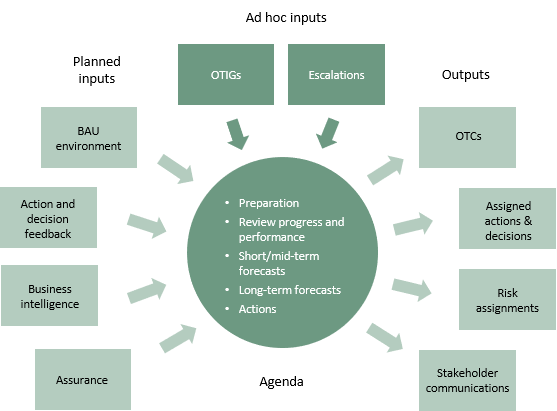This node recognises the Main Board as the primary leadership, governance and decision-making body within the organisation. It presents two sub-groups that focus on operational strategies and change strategies. The example agenda focuses on the change sub-group.

A key driver of BIG is to facilitate “from strategy to delivery and back again”. Regular reviews at Main Board level are driven by planned inputs from portfolio level as well as ongoing inputs from the business environment.
The Board must also deal with ad hoc inputs such as short term business issues and escalated issues from the portfolios.
Revised OTCs will be fed back to Portfolios and BAU. Board decisions will result in actions being assigned and the Board review processes may also result in new risks being identified. Appropriate stakeholders (such as shareholders or regulators) will receive communications direct from the Board.
| Input | Agenda | Output |
-
MI covering regular performance and forecasts, or supporting ad hoc submissions.
-
New and ongoing stimuli - OTIGs.
-
Analysis of strengths and weaknesses in current state.
-
Progress on objectives, targets and challenges including specific issue escalations (e.g. customer, staff, funding, resourcing) from their owners in respective domains.
-
Progress on actions and decisions. -
Assurance feedback. | Meeting Preparation, e.g. -
Confirmation of data quality, updates on action and decision status. -
Analysis of what has changed within existing business drivers. Review progress and performance, e.g. -
Changes to the business environment. -
Status of objectives, targets and challenges. -
Exceptions and escalations, -
Resourcing and financial performance Forecasting – Short/Mid Term, e.g. -
Establish confidence in predicted outcomes for objectives. -
Forecast resourcing and financial performance vs. target -
Determine risks and issues that require actions or decisions Forecasting – Longer term, e.g. -
Identify strategic risk, in particular changes in opportunities and threats. -
Document changes in strategic goals or imperatives along with funding implications Meeting Actions | -
Revisions to existing objectives, targets and challenges.
-
New objectives, targets and challenges.
-
Actions, decisions and risks assigned to owners.
-
Funding and resourcing decisions communicated. -
Communication to stakeholders. |
Thank you to the Core P3M Data Club for providing this page.






